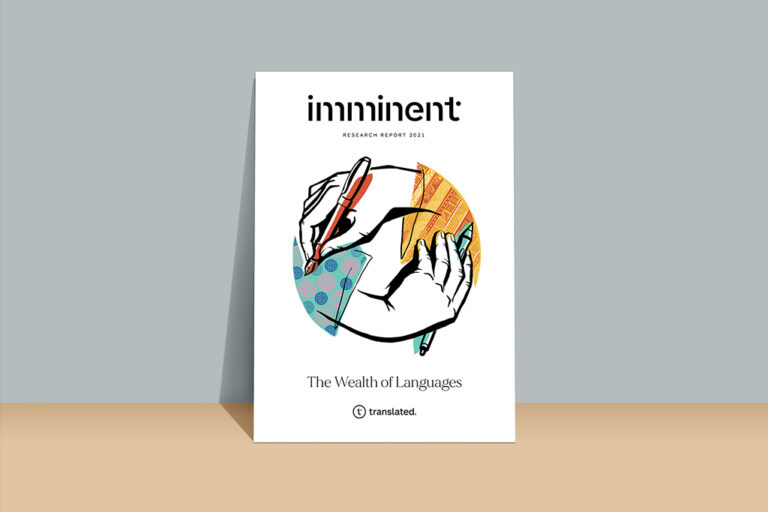Technology
I have always liked playing with words, and I was lucky enough to be able to grow up bilingual thanks to my parents, who were able to transform the curiosity of a constantly chattering little girl into a talent that then became a profession. This curiosity is still with me today, alongside the good fortune of having a job that I can do anywhere, anytime. The beauty of ageing, they say, is experience. Well, being a translator for over 30 years also meant growing up with all the tools of the profession: from a typewriter with the text to be translated at one side, to the first machines that stored three or four lines, to the first assisted translation tools, to machine translation, through to the introduction of Artificial Intelligence to supplement CAT tools, which had previously followed a parallel path with no crossover.
It was a privilege to have the opportunity to embrace new technologies and, in particular, to participate (albeit as a guinea pig initially) in the development from the earliest beta version of one of the very first computer-assisted translation tools able to combine machine translation with the typical features of a CAT tool, as well as uploading everything to the Cloud, thus making it possible to work anywhere, from any PC. Today there are many tools of this type, but the fundamental thing about this experience for me was that it meant I was no longer forced to endure a tool I needed to master, one created by scientists on the basis of generic data. Together with other colleagues, I was privileged to contribute to the creation of this tool: taking into account the limits of the typical parameters of computer science, I was able to combine these limits with my personal requirements as a translator, minimising complications and ensuring that I could use what for me are the most important features both in a CAT tool and in machine translation.

Imminent Annual Report 2021
Fit your business in global shape. Get your copy of Imminent Annual Research Report 2021. And let us know what you think.
Get your copy nowFor the same reason, I truly believe that I can offer an honest and sincere reflection on what being a technical translator means today, with all the tools available and with what is now the topic on everybody’s lips: Artificial Intelligence.

So far, 2020 has been a shocking year in many ways, but it has given me the opportunity to think at length about the value and validity of Artificial Intelligence and to finally grasp the great underlying misunderstanding. Because of this pandemic, the words Artificial Intelligence are suddenly being bandied around everywhere – somewhat disproportionately, I would say, as far as my experience is concerned, because on the one hand this stokes our fears, and on the other it shows that we are not so advanced after all, or rather that we believe AI should and will replace us. On the contrary, what it can and must do is accompany and help us. Even in the world of translation. In my opinion, we have failed to understand this.
Some days and nights seemed never-ending during the pandemic. But every once in a while I found myself wondering: those famous robots that are now needed so much: where did they go? Why aren’t they in hospitals where doctors and nurses are risking their lives, when they, the robots, don’t have lives and therefore have nothing to lose? Why don’t they bring groceries to our homes instead of those underpaid young delivery riders who leave our packages outside the door for fear of getting infected? Why don’t they keep our elderly company while they are stuck in their homes for weeks on end, almost always alone for fear that a family member might infect them, when robots wouldn’t infect anyone since they cannot carry any viruses? And finally, why don’t they teach our children who cannot attend school? How many times have we seen little talking robots that promised to teach us all manner of things? Yes, of course, there are a few – often exceptions for marketing purposes. But overall, robots were not ready for the pandemic. So what use are we making of the famous AI?

Imminent Annual Report 2021
Fit your business in global shape. Get your copy of Imminent Annual Research Report 2021. And let us know what you think.
Get your copy nowIn fact, even in our world of translation, where AI was introduced to CAT tools in 2004, this observation has been fully confirmed. At first, our worry was being replaced by machines. Today, however, we receive a hypothetical, machine-made translation and we correct it. Today the price per word may have dropped, but productivity has increased, perhaps even tripled.
I was once able to translate five pages a day on average with a typewriter, with around 250 words per page; those five pages became ten after the introduction of CAT tools, and ten became twenty following the introduction of Artificial Intelligence in CAT tools.I have therefore achieved my goal: more speed, more productivity, less effort and more profit. But what is the real price we are paying, and not just as translators?
Machines recognise order in the chaos of immense amounts of often unstructured data. Immersed in these oceans of information, they formulate models that automatically recognise images and words, classify documents, choose routes for driverless vehicles, converse in natural language, predict equipment maintenance needs in factories, play Go, read X-rays to make diagnoses, and so on. These machines, taught to learn, are the form that Artificial Intelligence currently takes. No technology is mentioned more often today than AI. According to many analysts, Artificial Intelligence has reached the point of “hype” – obsessive attention that leads huge numbers of people to talk about a phenomenon, even when they do not fully understand it, due to excessive hope or misplaced fear.
“I have therefore achieved my goal: more speed, more productivity, less effort and more profit. But what is the real price we are paying, and not just as translators? “
Artificial Intelligence is, in fact, vaguely disturbing, because its name evokes the spectre of a non-existent interchangeability between humans and machines. But now, following the typical cycle of technological adoption, artificial intelligence in its current form is faced with the pivotal moment – the one in which it must keep its promises, or lower expectations. One thing is certain, however: it will not return to the laboratories from whence it came. The genius of “deep learning” that is developing on the market has now been proven to work, responding to the needs of an era invaded by data that must be managed and valued.

Nowadays we see newspaper headlines mentioning “Artificial Intelligence” on a daily basis, and most likely we are always and exclusively talking about machine learning software. Is that all there is? And how can we as users be afraid of something that we actually need all the time? What is the paradox behind this attitude? Let’s look at translation: to provide a translation, machine learning algorithms essentially use statistics and mathematics to find patterns, correlations and trends in huge amounts of data. By data, we mean everything that can be digitised and thus rendered smooth (or computer-readable): numbers, words, images, likes, videos. If information can be made digital, then it can be stored and later inserted into a machine learning algorithm. The result: machines learn to recognise order from the chaos of structured and unstructured data. They recognise images and words, classify information, analyse documents, converse with natural language, and choose paths, as in the case of self-driving vehicles. For now they are like children, learning with rather limited activities. So far, machines are simply automating activities, but we know they have the potential to learn, and this is what we are counting on.

Imminent Annual Report 2021
Fit your business in global shape. Get your copy of Imminent Annual Research Report 2021. And let us know what you think.
Get your copy nowIn my opinion, the point is this: what is the quality of the data we are inputting? Personally, judging by the texts I review, translated by perhaps younger colleagues, I would say very low, if not outright bad. This means two things: the first is that we are teaching machines to translate badly, and the second is that we are lowering the quality of the result. And there is one more thing, the worst of all: in the end, the language we end up speaking will be as poor as the one we find ourselves reading. For example, if we do not teach machines to use the subjunctive in Italian (or any of the other magnificent treasures of the Italian language), the subjunctive will disappear. If we do not use as many synonyms as possible, Italian vocabulary will deteriorate. And so on.
I have been a translator of medical texts of all kinds for many years now, so allow me to draw a parallel. According to experts, in order to design the future of AI in medicine, we must start by listening to the real needs of patients, and the mutual needs of scientific communities that seem to have little to say to one another: doctors, biologists, pharmacologists, physicists, engineers, computer scientists… The only way to harness years of research is to talk to each other. In order to do so, we need two things: a clear grasp of the problem to be solved, and a humble attitude. Everyone needs to have an extensive willingness to listen. The key term is “cross-fertilisation”, which sometimes happens today and sometimes doesn’t. This listening technique was the basis of the project which I was and still am a part of. But how much are we really being listened to? In other words, are our doubts as users of Artificial Intelligence tools worth anything? Isn’t it the other way around: that neural machine translation competes with human translation? Is that what we wanted?
The rapid growth in the need for companies to serve an increasingly diverse and global online customer base has also driven the need to do so in the customer’s preferred language. The profitability of companies rightly guides their choices, and controlling costs is fundamental. The extraordinary technology of Neural Machine Translation (NMT) is obviously different from conventional statistical machine translation based on phrases, historically used in services such as Google Translate. Today, Google’s NMT approach seems to work well for certain language combinations. This means that it is able to translate content from various languages into others with very few errors or corrections; this, of course, has allowed Google to affirm that sometimes “human translation and Google’s Neural Machine Translation are practically indistinguishable”. Naturally, I leave it to those who study the sector from other points of view to reflect on the appropriate choices, often dictated by the economic importance of certain language combinations compared to others.
“Does Machine Translation alienate customers?”
Outside the box, machine translation is rarely able to choose the words that are best suited to certain sectors or consumers. Machine translation programs are not (YET?) able to grasp this difference, and consequently they use a predefined word that often does not reflect the brand’s creative intent. It’s up to us to do this. But this is where I’d like us to think together. Does Machine Translation alienate customers?
Does Machine Translation alienate customers? The stakes could be much higher than simply presenting translated content that is unattractive or difficult to understand. Of course, poorly translated content is a serious problem and weakens a brand’s credibility. It can penalise automatically translated sites by lowering their position on search results pages and – in severe cases – by removing sites from indexes altogether. That’s why the combined use of human translation and translation management technology can boost the impact of websites in international markets, dramatically increase global SEO, and reduce costs compared to other solutions. There are some companies that attach particular importance to lexical choice, wordplay and creative writing. Furthermore, all sectors dealing with very sensitive content, such as family accounting, health or regulatory compliance, are particularly at risk of errors. With a tool that integrates Machine Translation with human creativity, you get so-called contextual integrity, i.e. a holistic (or complete) view of the content.
However, what matters in the current model is reducing costs and maximising impact.

Imminent Annual Report 2021
Fit your business in global shape. Get your copy of Imminent Annual Research Report 2021. And let us know what you think.
Get your copy nowIn short, there is no doubt that we are living in a very exciting era, and the surprising giant steps taken in the field of Neural Machine Translation quite rightly caused a stir at first and then changed the market. However, AS YET, no form of Machine Translation can match that carried out by a qualified translator. Professional translators can capture creative nuances, modify translations to respect space limits, and produce translations that reflect a brand’s voice like no machine will ever be able to. The simplistic concept of translation as “word substitution” rather than the “transmission of ideas” is in part responsible for the thinking of those who believe that machine translation is close to reaching the levels of professional translation. However, due to the intricate and intrinsic nature of the language-thought relationship, we can only be sure that a machine can translate as well as a human being when we have fully understood and reproduced the functioning of the human brain. In the view of some people, this is certainly not happening right now, nor will it happen for a very long time to come.
“The simplistic concept of translation as “word substitution” rather than the “transmission of ideas” is in part responsible for the thinking of those who believe that machine translation is close to reaching the levels of professional translation.”

I think something different is happening. I think that, as always, human beings are pursuing profit without thinking about the consequences in the long term. We are dulling the language, whereas we should be able to take advantage of the exceptional opportunity to work TOGETHER with machines to enrich it.I have another very serious consideration brought on by the catastrophic scenario of the pandemic. During the pandemic, the Internet gave us the opportunity to communicate, to talk to others who live far away, and to continue working remotely. I imagined a blackout, where I paradoxically had to go back to my old typewriter. While it is true that today I can translate 6,000 words a day and reread and deliver them, while with my old typewriter many years ago I could barely deliver 1,300, I know for sure that today, without the suggestions from the machine, my productivity would be even lower because I also know for sure that my mind has become lazy.
Is there a solution to this kind of laziness? Is the lower quality that I notice a consequence of this laziness? Or vice versa? In short, do the speed and productivity resulting from a profit-seeking economic model make people richer or actually poorer?
“In short, do the speed and productivity resulting from a profit-seeking economic model make people richer or actually poorer?”
Last but not least, I would like to mention a very interesting book by Nicholas Agar, entitled How to Be Human in the Digital Economy. Written in 2019, it is a decidedly interesting read in my opinion, even now that all the parameters have been turned on their head. This book is not to be discounted. It talks about how the digital revolution is transforming human lives. Much of the upheaval of the previous Industrial Revolution was due to the automation of muscular strength … Each phase is typically shorter and shorter, isn’t it? The introduction of steam from 1760 onwards lasted almost 80 years, electricity another 40 years, how long for automation, if we start from the 1970s? 20 years? And how long will the peak of this digital revolution last? How quickly will it move forward and what will really change? In the digital revolution, according to the author of this book, the mental work of humans is being automated, thus posing a threat to occupations with high levels of intellectual content, i.e. professions that normally require many years of study, sometimes leading to high salaries.
But in reality, Artificial Intelligence is not applied in many fields where it is needed, and in other fields it seems that it does not represent a real threat to our workplaces, if we ignore the rapid improvement that AI has experienced in absolute terms when compared to human activities. According to the author, therefore, such a misunderstanding in favour of human beings is as unsustainable as Ptolemaic geocentrism was. He thus suggests distinguishing a different economy, which he calls the socio-digital economy. The main value of digital economy is efficiency, while the main value of social economy is humanity. The author concludes that we could choose not to realise the ideal of the socio-digital economy, continuing to consider technology as an influence in principle on the collective human experience. In doing so, however, we should expect (or fear) a dehumanised future, dominated in all respects by the value of efficiency. This would be a real, consciously programmed step towards extinction, having deliberately opted to “surrender our activities to the robotic and better versions of ourselves”.
“The main value of digital economy is efficiency,
while the main value of social economy is humanity.”
Nicholas Agar
I offer these sporadic reflections because I would like us to be able to discuss and understand where we are, where we want to go, and what are the real risks that we may not have thought through. I would like these thoughts of mine to be a source of discussion and debate.
Photo credits: Alexander Sinn, Unsplash / Surendran Mp, Unsplash / Neonbrand, Unsplash / Annie Spratt, Unsplash
